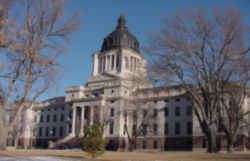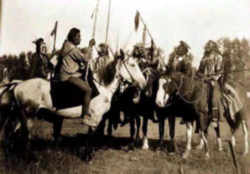


South Dakota Early History
First Early Inhabitants of South Dakota

Early history examines the archaeological record that tells the story of the first inhabitants of South Dakota. Learn about the prehistory and culture of the first early inhabitants, and what lessons it might teach us about the early history of South Dakota.
South Dakota First Early Inhabitants Timeline
- 80Mil BC - Upper Cretaceous Lance Formation in Montana, Wyoming and S. Dakota has fossils of Pachycephalosaurus (thick-headed lizards). They stood on two feet and were herbivorous. They had a dome-like development on the skull made of solid bone, most likely used in combat as a battering ram. It stood 5m and had spikes on its nose and around the back of its skull.
- c65 Million BC - T. rex "Sue" ate a Duckbill dinosaur and was herself mauled by another T. rex. She died in a slow moving stream near the shore of a vast inland sea that bisected North America, and was buried under a protective layer of sand.
- 11500 - 8000 BCE - Paleolithic period - Paleoindian hunters lived by hunting now extinct animals like mammoths and ice-age bison.
- 8000 -1000 BCE - Archaic period - Archaic peoples gathered wild plants and hunted more kinds of animals, living better off the land.
- 1000 BCE - Woodland period - People became more efficient at killing game like bison and deer. They could therefore live in larger groups.
- 200 BCE - Woodland period - People along the Missouri River built burial mounds and made pottery.
- 500 - The bow and arrow came into use, replacing darts and spears.
- 900 - Plains Village people (predecessors to the Mandan, Arikara, and Hidatsa peoples) began to plant corn, and sunflowers, in addition to hunting. They lived in earth lodges within villages protected by ditches and log palisades.
- 1500 - Plains Village people were living all along the Missouri River valley. There is also archaeological evidence of their hunting camps all throughout the state.
Early History of Native Americans in South Dakota
The Indigenous People of South Dakota
Archaeologists have found evidence that a band of Paleo-Indians hunted and killed two mammoths around 11,000 years ago in a swampy area that would eventually become the Badlands area of South Dakota. These are first South Dakotans we know of. It is believed these people were part of a group called the Clovis people who were centered in New Mexico. We know from artifacts that they made arrowheads for hunting, but we know very little else about these people.
There is also evidence of another group of people, hundreds of years later, living in South Dakota. By this time, the land had changed and the swamps were now wide plains which supported large herds of giant buffalo (bison). These people, called the Folsom people, hunted the bison and also lived on wild onions and prairie turnips. They made beautiful arrowheads that they used for hunting. Again, we do not know what happened to these people or why their culture died out.
After several more centuries passed, the climate became warmer and drier. A new people, called the Plains Archaic people, migrated to the area.
By this time, the giant buffalo had died out and were replaced by smaller bison which these new people hunted along with deer and rabbits. These people
also learned how to store food for times of drought, and lived in small groups because the land could not support large settlements. This group also
left the first written records in South Dakota in the form of images carved into the walls of caves. These symbols and pictures are called petroglyphs.
By about three thousand years ago, another group of people came to live and hunt in the area. This group, called the Woodland people, lived in larger
groups. They were much more successful in hunting the American bison that lived on the land. They also traded with groups living further to the east,
and honored their dead by building burial mounds. They lived in houses built of sod and grew corn, pumpkins, sunflowers, squash, tobacco and beans.
By the time the first Europeans arrived in the area, these people could be grouped into different tribes, including the Arikaras, the Mandans, Crows,
the Cheyenne, and the Pawnee. Eventually, the Dakota, Lakota and Nakota (later known as the Sioux) people moved into the area from Wisconsin and other
more eastern areas.





